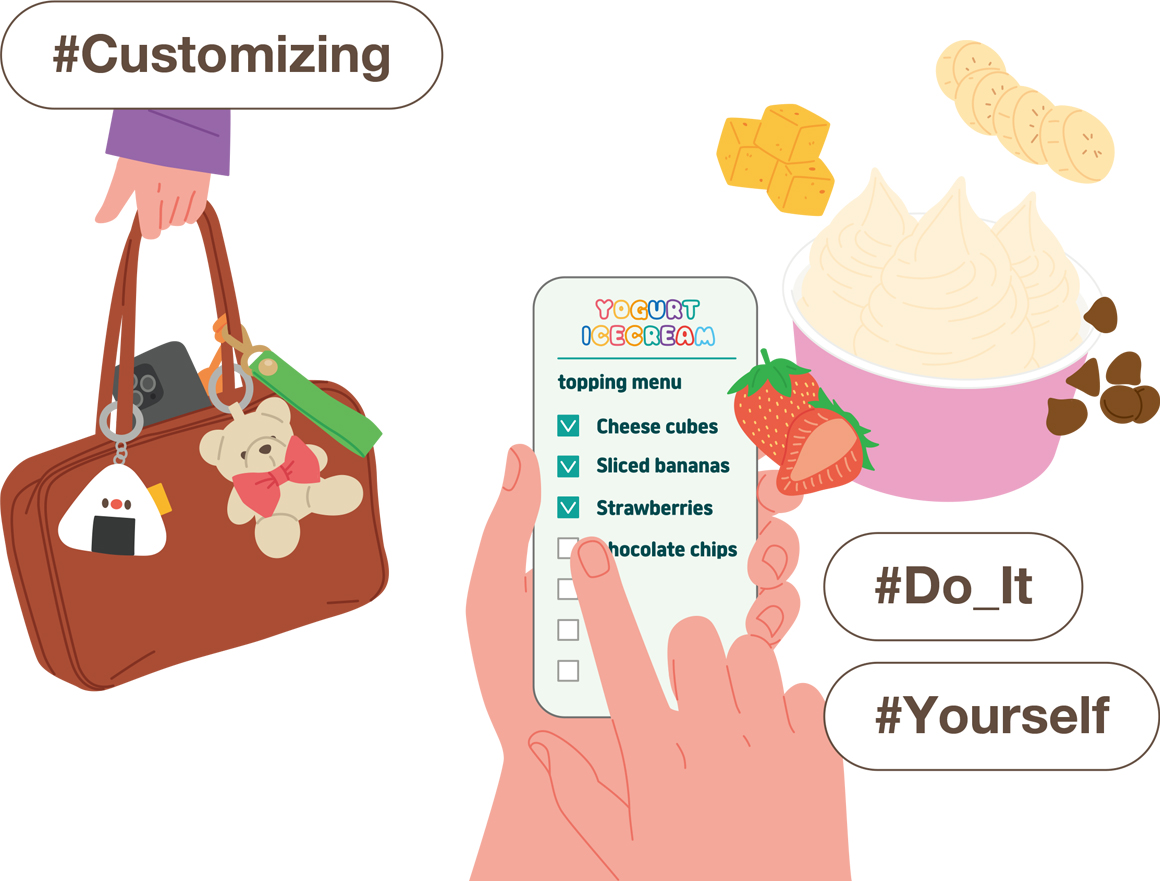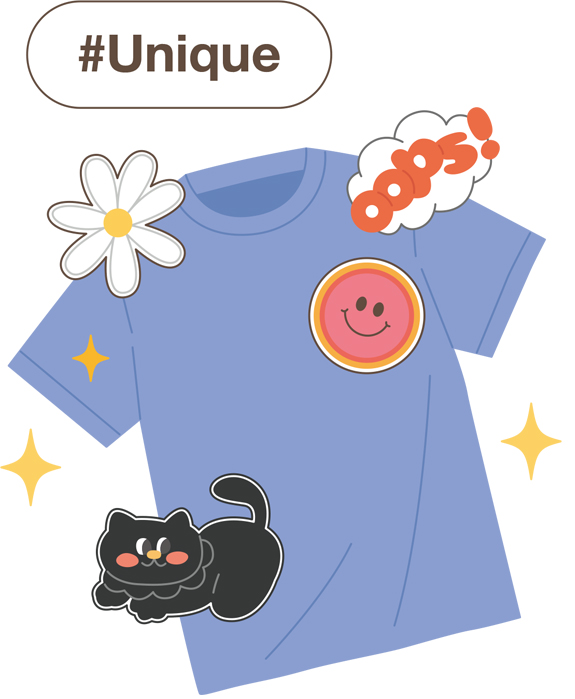
Customization has been all the rage in Korea for several years now, and there are no signs it’s going away. Customers all over the country can have their products tailored to fit their personal preferences.
Writer. Sung Ji Yeon
Illustrator. RYUGOON
Koreans today have taken to embellishing words with the suffix kku, the first syllable of the word kkumida, meaning “decorate.” The suffix can be added to anything that can be accessorized, such as backpacks (gakku, from gabang+kku) and shoes (sinkku, from sinbal+kku). That has inspired slang such as the phrase byeoldakku, a short form of the sentence byeolgeol da kkuminda (everything is being decorated). It’s also given rise to the concept of the “topping economy,” where people purchase a basic product and then tack on preferred options as you might throw toppings on a pizza. In the end, all these words reflect just how dominant the decoration trend has become in Korea. How did decoration become a trend, and what exactly are Koreans so eager to decorate? That’s what we’ll explore in this article.
The industry where customization is most dominant is food and beverage, with custom-made cakes being a prime example. Cake designers start with a custom design based on the buyer’s request and then add flavors, packaging, and special features, ultimately producing a one-of-a-kind concoction. The trend for unique cakes has already become an indispensable part of Korean dessert culture. But nowadays, not only cakes but almost any kind of food available on delivery apps is capable of customization. One trend that has swept the country over the past year is custom-made frozen yogurt. Having complete control over size and toppings, including sauces and sweets, has become wildly popular. And now that degree of customization is available for a wide range of foods and beverages.
The fashion world has also taken up the customization trend. A kind of customization beloved with people of all ages is the key chain approach. That means attaching a small doll or knickknack to a personal item—a backpack, Bluetooth headphone set or mobile phone, for example—to represent one’s personal interests. As you walk down the street, it’s common to see people’s stuff dangling with key chains that prioritize style over comfort. Another fashionable form of customization is putting one’s unique spin on off-the-rack items. That can mean turning free shopping bags into backpacks, unworn jackets into watch straps or skirts, and name-brand buttons into earrings or other distinctive accessories.
In recognition of these trends, brands have been offering more customization services and events. One shoe brand handed out paints and markers so that customers could decorate their shoes after purchase. Similarly, an apparel brand launched a service where customers could bring in old clothes and have them adjusted to their taste. That fits into the trend of promotional pop-up stores providing room for customers to customize their products.
These aren’t the only areas where the customization trend can be observed. There are also beauty services that let shoppers customize cosmetics cases according to their preferences and even adjust the ingredients to better match their skin types. Electronics companies sell home appliances that can be assembled in customers’ preferred colors. There are also services that offer custom-made mobile phone cases or that slap stickers and other doodads onto cards displaying the photographs of K-pop stars.

The concept of customization is hardly a new one. It just wasn’t used very often for reasons of efficiency—the costs were too high, and it took too long for customers to actually get the items they’d ordered. Before customization became a trend, the shoe industry was the only one in Korea where custom-made services were in standard use. That underlines the massive impact of the customization trend, which is currently sweeping the country.
Considering that custom-made products have always been part of the culture, why did the practice gain such currency all of a sudden? Partly, that’s because young people in Korea (just as in other countries) value originality. But it’s also because the process of customization is itself so enjoyable.
We live in a time when almost any product is easy to find and purchase. When items weren’t so easy to come by, the end product was by far the most important thing. But today, things are different. People have started searching for values that speak to them. They’re looking for personal meaning, for something that will set them apart from others. As a result, customers have come to pay more attention to “process.” Put another way, people today are no longer focused solely on purchasing and possessing things. Since the process of acquisition is itself a form of experience, people eagerly seek processes that offer novel sensations even if the outcome is nothing special.
Ultimately, customers are taking pleasure in their encounter with products, or in other words in the very concept of customization. Brands that have intuited these trends have been emphasizing customization not so much as a kind of premium, but rather as a way for individual customers to differentiate themselves. That has enabled those brands to boost customer satisfaction and loyalty at the same time. So it doesn’t seem as if Korea’s customization trend will be fading any time soon. If anything, it may become established as a distinctive part of Korean culture.
That slang term we introduced earlier—byeoldakku, meaning “everything is being decorated”—remains relevant since the decoration trend is still in full swing. It’s already touched cosmetics, clothing and home appliances. It’s exciting to contemplate what may be the next big thing in Korea’s customization trend.
